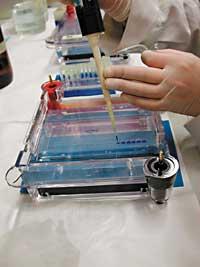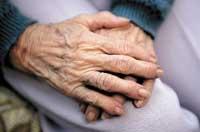Parkinson in family
2005/02/01 Andonegi Beristain, Garazi - Elhuyar Zientziaren Komunikazioa Iturria: Elhuyar aldizkaria
Hereditary parkinson's appears in only 10% of Parkinson's cases. However, these cases offer special research possibilities, since in the same family there are several members who can develop the disease, so it is possible to investigate the disease from the beginning to the end.
As in many other hereditary diseases, genes have a lot to say in family Parkinson's, and the real key is in mutations. At the moment, six hereditary Parkinson genes have been described in the world and a group of UPV studies two of them: alpha-sinucleine and parkina.

Three mutations of the alpha-sinucleine gene are known, one of which has been recently detected in the Basque Country, the E46K mutation. In this Basque family, in addition to Parkinson, a type of dementia appears, the dementia exercised by the Levy bodies. The disease begins to develop at age 50-65.
Map of hereditary Parkinson in Euskal Herria
Studying families with Parkinson's in the Basque Country, researchers want to find the usual mutations here. In fact, blood samples from other family members who have this mutation have been analyzed at UPV-EHU to determine whether the mutation is the cause of the disease and how it evolves.
In addition, samples of other patients from the Basque Country and Italy have been analyzed with the same diagnosis. But no remains of the E46K mutation have been found. And they have also conducted a retrospective study with samples of other patients who died between 1998 and 2003, with the same result: they have not found carriers of the mutation. This is not uncommon, as alpha-sinucleine mutations usually appear in a single family.
Methodology
For the studies, the researchers extract the DNA from the leukocytes from the blood samples of the patients and subsequently make copies of that DNA, as the analysis requires millions of copies. The analysis is performed on an automatic sequencing machine that decodes the DNA chain.
The real work of researchers follows an almost automatic process. To find mutations in the DNA code, decoded samples are compared to a DNA model, a DNA chain without mutations. So, check for any mutations. With this methodology, in addition to alpha-sinucleine, UPV is investigating the parkina gene. This last gene causes many cases of hereditary Parkinson's in Europe.
The research of this gene will serve, on the one hand, to assess the frequency of this mutation in our environment and, on the other, to analyze the influence that this mutation may have on the appearance and development of the disease. However, researchers want to develop the map of hereditary Parkinson's in the Basque Country and then start other studies.
- The project is entitled Estudio de los genes alfa-sinucleina y parkina en el Parkinson.
- Objective To determine the frequency of mutations and evaluate their possible incidence in the genesis and development of the disease.
- Director Marian Martínez de Pancorbo.
- Team M. Martínez de Pancorbo (1), M. C. Gonzalez (1), J. J. Zarranz (2,3), E. Lezcano (3), J. C. Gómez Esteban (3), F. Velasco (3), B. Atares (4).
- Departments and Faculties (1) Genomics Service: DNA bank. Faculty of Pharmacy, UPV (Vitoria-Gasteiz). (2) Department of Neurosciences. Faculty of Medicine and Dentistry, UPV/EHU (Leioa).
- Hospitals (3) Neurology Service. Cruces Hospital (Barakaldo). (4) Pathological Anatomy Service. Txagorritxu Hospital (Vitoria-Gasteiz).

Gai honi buruzko eduki gehiago
Elhuyarrek garatutako teknologia





